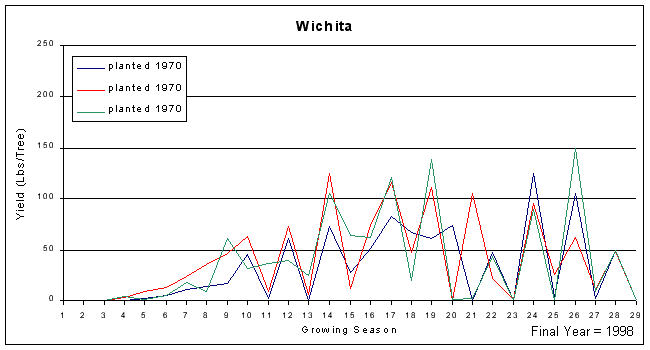Wichita

Average nut quality of test trees.
| # Nuts / lb. | % Kernel | Kernel quality breakdown | Specific gravity | ||
| % Fancy | % Standard | % Amber | |||
| 60 | 56% | 16% | 33% | 7% | .78 |
History
'Wichita' is a selection from a cross between 'Halbert' and 'Mahan' made in 1940 by L.D. Romberg at the Pecan Field Station in Brownwood, TX. In 1949, scion wood from this selection was distributed to growers for trial studies. It was named and released by Romberg in 1959 (Sparks, 1992).
Comments
*Note: This is an older cultivar planted in the Young Variety Test at the Tifton Campus. Trees were planted decades ago when care was very different than it is now, and trees received much less care, so production data will reflect this fact. Trees began receiving insecticides in 1962, fungicides in 1970, nitrogen in 1962, and drip irrigation in 1975. The data for this cultivar was collected by several individuals, but the bulk of the data and the comments are from my predecessor Dr. Ray Worley. This information was originally published here: Worley and Mullinix, 1997.
'Wichita' is one of the most widely planted USDA cultivars. When grown under suitable conditions, it has proven to be an outstanding cultivar as a young tree. Nuts are medium-sized with high percent kernel and good fill. The extreme susceptibility to scab and water-stage split condemn it for use in the Southeast. Our results are probably better than could be expected in solid plantings of 'Wichita', because scab pressure was less. This cultivar has been disastrous for most growers in the East.
Production record of test trees beginning in year planted
'Wichita' production from the Young Variety Test. Each colored line represents the yearly production in pounds of nuts from an individual tree beginning the year planted.
Alternate Bearing Intensity* = 0.67
*Computed from mature trees using data from years after trees began receiving fertilizer and pesticide sprays.

